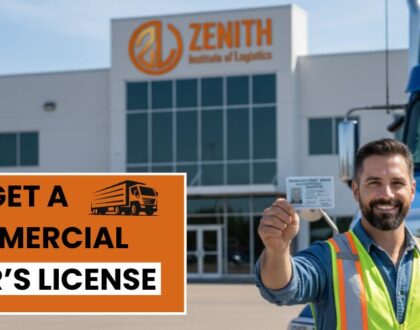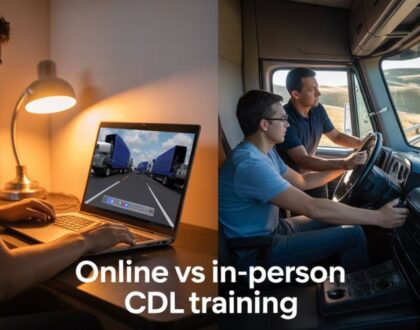What Type of CDL License Is Required to Drive a Truck, & How to Earn Them

Moving freight safely depends on well-prepared drivers. Having a CDL is the most crucial aspect in the US, as all your preparation to become a successful driver starts with this license. Before you begin the process, it’s important to get a few things straight – federal rules and state rules regarding Commercial Driver’s License are divided into three classes so that every driver is trained for the weight and cargo they carry.
And now, without wasting any more time, we will explore what the CDL is, how to obtain each one, and the everyday responsibilities of a professional truck driver below.
What Is a CDL License?
A driver earns a CDL by passing a set of tests and meeting a series of requirements. It’s a state credential that permits you to operate a commercial motor vehicle (CMV). Federal Motor Carrier Safety Administration (FMCSA) regulations are the minimum, but every state grants a license on the basis of its written and road tests.
The CDL has medical, knowledge, and background testing that is more stringent than that of a normal car license. It also has stricter punishments for traffic offences. Such stricter requirements safeguard the passenger vehicles on the highway, since a loaded truck might have to weigh more than twenty times that of a passenger sedan.
Core CDL Requirements
Here are some of the most crucial CDL requirements:
- Age: You must be at least 18 for in-state driving. For crossing state lines or hauling hazardous materials, you must be at least 21.
- Normal driver’s license: It should be in good condition.
- Medical fitness: A certification of physical examination from the department. of transportation (DOT).
- Clean background: Hazmat and Transportation Security Administration on a ten-year driving record check.
What Are the Different Types of CDL Licenses?
| Class | Vehicle description | Common uses |
| A | A gross combination weight rating (GCWR) of 26,001 lb or more and the trailer exceeds 10,000 lb | Long-haul tractor-trailers, doubles/triples, tankers, livestock |
| B | Single vehicle 26,001 lb or more, or combination where the trailer is 10,000 lb or less | Straight trucks, dump trucks, city buses, and large delivery vans |
| C | Vehicles that do not meet A or B but carry 16 or more passengers (including driver) or hazardous materials | Shuttle vans, small school buses, hazmat sprinter vans |
Class A CDL license
The scope of the Class A CDL license is the most broad in terms of heavier rigs, including 53-foot dry vans, flatbeds, and refrigerated trailers. Because most of the long-haul interstate freight moves in these units, the job market and the pay range are widest for the Class A holder.
The skills testing includes backing up full trailers, coupling and uncoupling the trailers, and negotiating steep grades. Many employers like to see extra endorsements, such as T (double/triple trailers), and X (tank plus hazmat), to improve flexibility.
Class B license
A Class B license allows the operation of large single-body vehicles, for example, cement mixers, garbage trucks, and municipal buses. Training time is shorter than for Class A because there is no trailer to manage.
This license suits drivers who want local routes with daily home time. You can upgrade to Class A later by passing the additional skills tests.
Class C license
Class C is designed for smaller commercial vehicles that pose special safety hazards, including passenger transport and certain dangerous goods.
Endorsements and Restrictions
Endorsements expand what you can drive; restrictions limit it. A few common codes:
T – Double/Triple Trailers
N – Tank Vehicle
H – Hazardous Materials
P – Passenger
S – School Bus
E – Automatic transmission only (restriction)
How to Obtain a CDL License
It’s really simple if you follow these tips:
- Study the CDL manual. Every state publishes a free handbook that matches the exam.
- Apply for a Commercial Learner’s Permit (CLP). Pass knowledge tests for your class and any planned endorsements. Submit proof of identity and your DOT medical card.
- Meet Entry-Level Driver Training (ELDT) rules. Since 2022, first-time Class A or Class B applicants and all hazmat, passenger, and school-bus endorsements must complete an ELDT course from a school listed on FMCSA’s Training Provider Registry. A quality CDL training program will handle this paperwork for you.
- Practice with a licensed mentor. Federal law requires that a CDL holder ride beside you anytime the CLP holder is on public roads. Most schools supply instructors and training vehicles for this stage.
- Pass the three-part skills test. First is the pre-trip inspection – show that you can spot mechanical issues. Second – the basic controls – straight backing, offset backing, and either parallel backing or alley dock, depending on the test site. Lastly, road test whether it’s city, highway, and tight-turn driving.
- Pay fees, get fingerprinted if needed, and collect your card. Some states print on the spot; others mail within a week.
For a deeper breakdown of the process, check our full guide on how to get a Commercial Driver’s License
How Long Does It Take to Earn a CDL?
Most full-time Class A programs take about 160 hours, which usually comes out to four weeks of training. Part-time evening or weekend schedules extend the timeline to eight or twelve weeks.
Class B programs move faster and usually wrap up in two to three weeks since there’s no trailer work involved. You may need extra time if a TSA background check is required for hazmat. From the first day of study to getting your card, most students finish within two months. For a deeper look at timelines and factors that affect them, refer to our CDL training duration guide.
Responsibilities of a CDL Driver
- Vehicle inspection and maintenance
Federal regulations require that before a driver leaves the yard, he/she must ensure that “every part and accessory is in good working order.” Pre-trip, mid-trip, and post-trip inspections must be made, with reports being written of defects found and necessary shop work scheduled.
- Safe vehicle operation
A tractor-trailer requires approximately twice the distance that a car requires to stop. As a driver, you are responsible for controlling the speed, the distance between the car ahead, and being in the right lane. Braking on downhills is also an essential thing you have to control.
Other than that, the Hours-of-Service law also restricts the daily and weekly driving hours, and thus, you need to calculate your rest breaks.
- Time management
Freight contracts include strict pickup and delivery windows. Weather, traffic, and mandatory rest periods can all erode the margin. Skilled drivers plan alternate routes, legal parking spots, and fuel stops before the wheels roll.
- Cargo handling
FMCSA cargo-securement rules state that freight must not shift or fall. You will inspect straps, chains, doors, and seals at the start, again within the first fifty miles, and at set intervals later on. For tanker or live-animal work, you also monitor liquid surge or animal welfare.
Picking the Right CDL Training Program
The market is crowded, so compare:
- Accreditation and ELDT listing – Required to satisfy federal law.
- Instructor ratio – More wheel time per student means faster skill growth.
- Equipment – Practice in vehicles like the ones you will test and later drive.
- Job placement – Strong links with carriers shorten the wait for your first paycheck.
- Cost transparency – Tuition, test fees, medical exams, and any retest costs should be clear up front.
A good school saves you money by focusing on the class and endorsements you actually need, not selling extras you will never use.
Conclusion
The right road to a career in truck driving begins with the careful choice of the kind of CDL license best suited to the freight you wish to haul. The Class A CDL license allows the broadest range of heavy combinations, the Class B is appropriate for large single vehicles, and Class C is required for passenger vans and hazmat in smaller units. Each choice calls for a different kind of testing, a different schedule, and a different kind of duties to perform, but all take into account safety inspections and time management.
At Zenith Institute of Logistics, we assist future drivers every step of the way. Our state-approved CDL training program covers all ELDT regulations and offers modern equipment, scheduling your skills test as soon as you are ready to take it. Experienced instructors provide you with the details of the inspection, backing drill, and trip planning programs until you feel confident that you can pass the testing process.
Recommended Posts

How to Get a Commercial Driver’s License?
October 30, 2025

Online vs In-Person CDL Training: Pros and Cons
September 19, 2025

Do You Need a CDL to Drive a Straight Truck?
April 30, 2025

